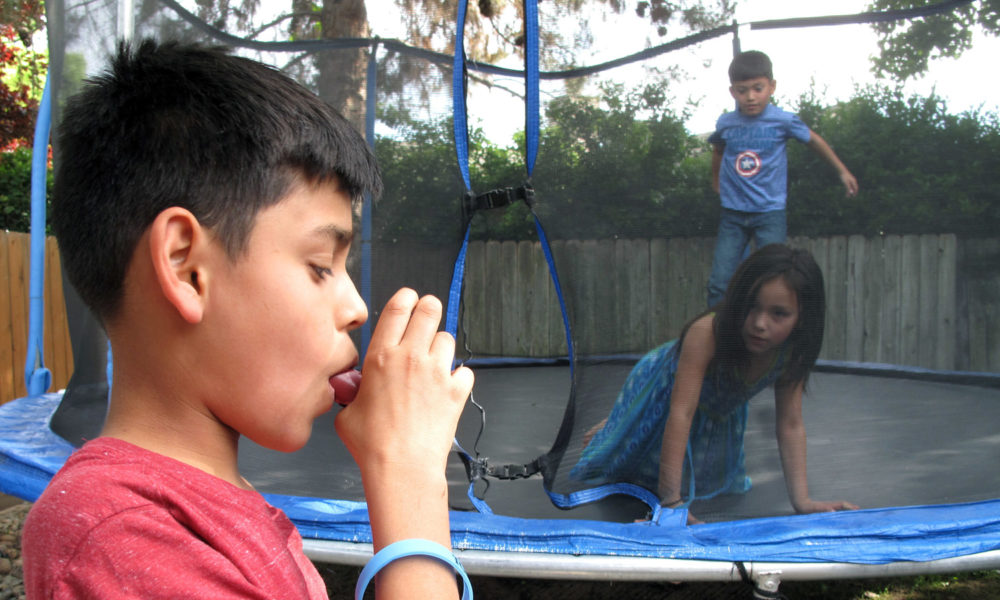The Trump administration has abandoned our nation’s mission of protecting kids based on the best evidence. From unsafe strollers to harmful chemicals, the Union of Concerned Scientists illustrates the harms, figuratively and literally, using a wide range of examples in a new report and a storybook for adults, “Breathe In the Smog, Drink In the Lead: A Grim Scary Tale for People Who Care about Kids.”
There is nothing more universal than the overwhelming need that humans have to protect our kids. That’s why I find it particularly egregious that an administration has done so much to undercut the futures of so many kids across the country. Parents need to be able to trust that our government is watching out for kids. Unfortunately, we have found time and time again that the political appointees that make up the Trump administration have chosen to prioritize industry profits and political wins over children’s health.
This is a wake-up call for everyone who cares about kids to demand a shift in those priorities. The stakes cannot be any higher when the health of our kids is on the line.
In our research, we found that Trump administration decisions are putting some children and families in immediate danger, threatening the long-term health of many, and stealing futures of this generation and others to come.
Immediate threats
The most heart-wrenching Trump administration action is the way in which migrant families and children are being treated at the US-Mexico border. Inhumane policies have meant the separation of children from their loved ones, which threatens the immediate and long-term physical and mental health of children and family members who have already been through unimaginably difficult circumstances.
Cuts to coverage under the USDA’s Supplemental Nutritional Assistance Program could mean the end of food assistance to millions of children in low-income households, despite there being overwhelming evidence of the benefits to the health, educational success, and future economic success of children.
The Trump administration is failing to enforce laws it has on the books across agencies. We found this to be particularly egregious at the Consumer Product Safety Commission (CPSC). The number of recalls of children’s products dropped by 60 percent between 2016 and 2017 and rather than address the problem, the agency eliminated a team tasked with finding defective children’s products in 2018. Today recalls of children’s products are at their lowest level in a decade and the number of fines levied for corporate misconduct has dropped by half.
Increased line speeds at pork and poultry processing facilities coupled with fewer federal inspections will spell food safety troubles, according to the USDA’s watchdog and former government employees. Children, whose immune systems are still developing, are more vulnerable to the detrimental health effects of food-borne illness.
Weaker air-pollution rules could expose children to higher levels of contaminants like fine particulate matter and ground-level ozone, meaning that the benefits of preventing hundreds of thousands of asthma attacks, respiratory illness, and missed school days will not be realized. Children are more vulnerable to the harms of air pollution because their lungs are still developing and they engage in more active, outdoor activities than adults. Children exposed to higher air pollution levels can develop serious health problems that affect their lungs and brains.
Long-term threats
There is a long list of decisions made by the Trump administration that fail to protect us from toxins in our air, water, and consumer products.
Lead is a potent neurotoxin and there is no safe level of lead in children’s blood. Despite this, the Trump administration’s update to its Lead and Copper Rule has actually decreased efforts to reduce childhood exposure, including cutting in half the number of lead water service systems that must be replaced.
In addition to lead, this administration has failed to use the science to adequately regulate asbestos, yet another well-studied and very dangerous toxin. It is still abundant in schools, homes, and other buildings our children spend time in across the country.
PFAS are synthetic chemicals used in a variety of products to repel water and grease. There are PFAS-contaminated sites across the country, but there are no enforceable health standards or designations of PFAS as hazardous wastes and therefore no requirements that polluters pay for cleanup. A new analysis in our report found that there are 3.6 million women of reproductive age and nearly three million children attending schools and childcare facilities within five miles of PFAS-contaminated sites who are likely at higher risk of health effects including decrease in response to vaccines, increased asthma risk, and damage to kidney functions. In fact, a recent EWG study tested drinking water across the country and found that the place with highest levels of PFAS—over 10 times the Agency for Toxic Substances and Disease Control’s safe level— was an elementary school in North Carolina. The political appointees at the EPA are putting the lives of our children at risk by failing to act.
The EPA also failed to ban agricultural uses of the pesticide chlorpyrifos, which went against the advice of its own scientists and the broader scientific community. Our analysis found that nearly 2 million children under age 5 living in agricultural communities are likely facing increased risk of harm to their brains and nervous systems. Just last week, the biggest manufacturer of chlorpyrifos (Corteva) announced it would be phasing out sales by the end of 2020 as a result of decreased sales. We should not have to rely on corporate response to public backlash before the federal government acts on the science.
Stolen futures
The thread that ties all of the examples in the report together is that the Trump administration acted without considering the science or following federal scientist advice. The results are more people—especially children—harmed. And the issue that has the greatest global implications and has been extensively documented by leagues of scientists is climate change.
A 2019 Lancet study co-authored by 70 researchers found that the global rise in temperature will be most dramatically felt by children. As for climate change, the complete failure of this administration to accept climate science and act to reduce carbon emissions is putting our children and future generations at risk. Extreme heat can cause pregnant women to experience abnormally high blood pressure, liver and kidney damage, and premature births, and children are more susceptible to under-nutrition, dehydration, and asthma and other respiratory diseases. Communities of color and low-income communities are already suffering from higher temperatures and will continue to suffer first and worst from these effects.
The Trump administration’s decision to pull out of the Paris Climate Agreement and the EPA’s efforts to roll back or weaken protections put in place to limit emissions has meant that children now and in the future will bear the burden of the actions of those that came before them.
Stand up for science and future generations
We are sounding the alarm to encourage parents and everyone else who cares about children to advocate for science-based policies that protect children from these preventable risks. When it comes to ensuring that we have clean air and water, we depend on our government to institute and enforce safeguards, so we have to hold our elected officials accountable. That means exercising our democratic rights and making sure our elected representatives know that we are watching and we are demanding that they represent our interests over the interests of corporate polluters.
Once you read our new materials, check out our resource guide that features 20 partner organizations doing incredible work, actions you can take to protect kids’ health, and tips for talking to kids about these difficult issues. Together, we can make sure our kids’ health is prioritized as it should be.

